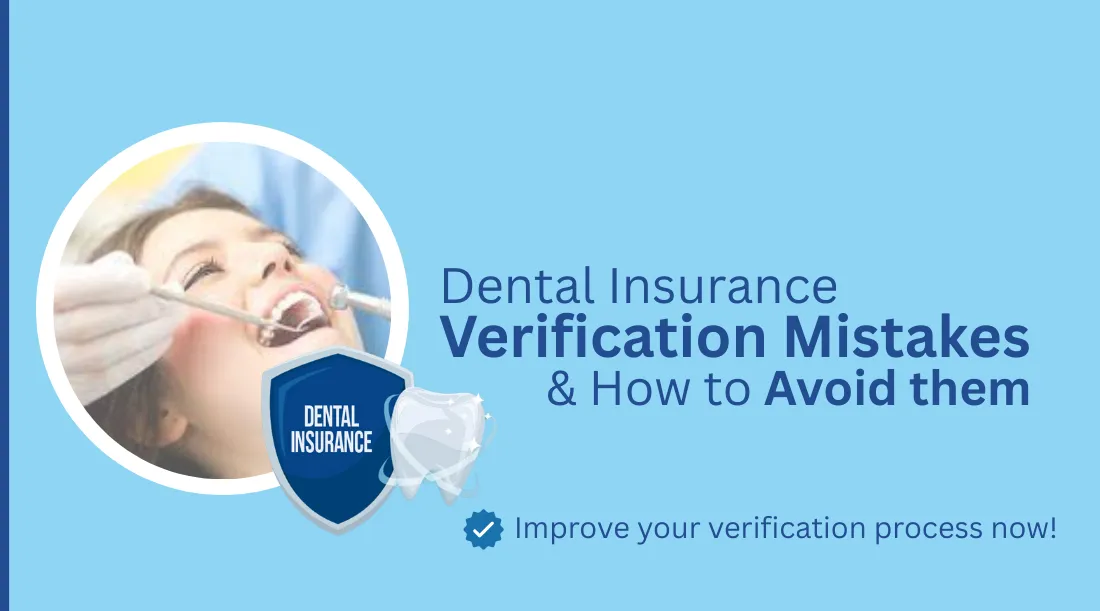
Accurate dental insurance verification is essential for seamless billing and efficient reimbursements. However, many dental practices experience frequent dental insurance verification mistakes that result in denied claims, delayed payments, and lost revenue. Incorporating effective dental insurance verification services and claim denial prevention strategies can make a significant difference in practice management.
In this article, we’ll discuss the most common verification errors, including common insurance verification errors in dental offices, and present actionable tips to avoid them—simplify patient billing for your practice and decrease claim rejections.
Table of Contents
ToggleThe Importance of Dental Insurance Verification
Dental insurance verification is an important process that guarantees precision in billing and efficient patient care. It includes verifying a patient’s coverage, benefits, co-pays, deductibles, waiting periods, and exclusions before providing services. In the USA, where insurance plans differ greatly, verifying these items prevents claim denial, billing inaccuracies, and financial issues. By precisely ascertaining patient eligibility and coverage, dental offices can minimize the risk of loss of money and ensure a seamless workflow.
Correct insurance verification improves patient satisfaction by being open to cost and coverage. This preemptive effort increases patient trust and improves the relationship between the patient and the practice.
Common Mistakes In Dental Insurance Verification
Proper dental insurance verification is necessary for avoiding claim denials and ensuring a smooth billing experience. Knowing how to avoid dental insurance verification mistakes is crucial to keeping your workflow uninterrupted. Yet, mistakes can happen, leading to delays and payment troubles. Understanding these errors and implementing claim denial prevention techniques can significantly reduce issues.
Delayed or Last-Minute Verification
One of the most frequent mistakes in the dental insurance verification process is checking insurance on the day of treatment. Last-minute verification can bring about unforeseen problems, such as gaps in coverage or expired policies.
Solely Depending on Predeterminations
Predeterminations may be confused with verification, but they do not make payments certain. Predeterminations are only estimates that can vary when the claim is processed.
Dependent On Stale Patient Coverage Information
Relying on outdated or incorrect insurance information, like policy numbers or plan coverage, can lead to the denial of dental claims. Patients can change employment or their insurance plans, causing a change in their coverage.
Incomplete or Inaccurate Patient Information
Minor mistakes such as misspelled names. Incorrect birth dates or incorrect policy numbers can result in claims denial. These common insurance verification errors in dental offices must be avoided. Even a single typo can cause issues during claim processing.
Failure To Understand Coordination of Benefits (COB)
If a patient has more than one insurance plan, correctly identifying the primary and secondary payers is important. If benefits coordination is not accurately carried out, it can result in claim processing inaccuracies or delayed payment.
Disregarding Frequency Limits and Exclusions
Most insurance policies come with certain restrictions on the number of procedures to be covered over a specific time frame. Disregarding these constraints may lead to claims denials and surprise charges to patients.
Inadequate Documentation on Insurance Claims
Claims made without necessary documentation, such as clinical notes or X-rays, tend to be rejected. Incomplete paperwork can lead to processing delays or direct denials.
Improper Coding and Application of Outdated CDT Codes
Incorrect or obsolete CDT codes are a frequent error. Because coding requirements are updated regularly, obsolete codes can result in denied claims and lost revenue.
Solutions to Prevent Most Common Dental Insurance Verification Errors
Timely Insurance Verification
Verify insurance at least three business days before the appointment. This allows time to fix discrepancies and avoid last-minute surprises.
Full Insurance Verification Rather Than Predeterminations
Never exclusively depend on predeterminations. Always perform a full verification to confirm correct coverage details. This practice averts payment problems on claim submission.
Maintain Patient Coverage Data Current
Update insurance information at each visit. Reverify policy numbers, coverage levels, and changes to prevent filing old information.
Enter Data Accurately
Instruct staff on how to properly enter patient information, such as names, birthdays, and policy numbers. Double-checking that data significantly prevents errors and the denial of claims.
Comprehend and Coordinate Coordination of Benefits (COB)
Educate your staff on the coordination of benefits and dental specifications. Proper determination of primary and secondary payers guarantees efficient processing of claims and avoids payment postponement.
Verify Frequency Limitations and Exclusions
While verifying, carefully observe limitations on frequency of coverage and exclusion. Informing patients about coverage limitations avoids surprise and disagreement.
Attach Complete Documentation
Send along all clinical notes, radiographs, and images that are required for submitting claims. Proper documentation assures the medical necessity of treatment and reduces denials.
Utilize Current and Correct CDT Codes
Keep yourself informed about recent CDT coding updates. Maintaining regular training on coding techniques for staff guarantees compliant and correct claims and significantly reduces the risks of rejection.
Advantages of Thorough Verification for Patients and Dentists
For Dental Practices:
Decreased Claim Denials
Carefully verifying insurance details helps avoid mistakes that can lead to denied claims and makes sure payments are received on time.
Financial Stability
Practices enjoy steady cash flow by reducing delays and mistakes in reimbursement.
Effective Billing
Correct insurance information accelerates the billing process, decreasing the administrative burden.
Enhanced Patient Retention
A smooth and transparent process creates good patient experiences, leading to repeat visits.
For Patients
Clear Financial Expectations
Accurate verification enables patients to know their coverage and out-of-pocket expenses upfront, avoiding surprises in the bill.
Improved Satisfaction
Patients enjoy honest communication, leading to confidence building and long-term loyalty.
Less Stress
Patients can make decisions regarding their care without fear of incurring additional financial costs.
Reducing Billing Disputes
When patients are informed about how much they owe early on, there is less possibility of disagreements afterward.
How We Help Your Dental Practice Prevent Insurance Verification Mistakes
In the busy dental practice management world, proper dental insurance verification is required to prevent dental claims denials and ensure hassle-free cash flow. The majority of dental practices are affected by recurring verification mistakes, leading to delayed payments and patient dissatisfaction.
We understand all these pitfalls and provide you with professional insurance verification services meant to prevent your practice from spending precious dollars on erroneous mistakes. We have a streamlined process of correct, prompt, and effortless verification so you can concentrate on caring for patients without anxiety over bureaucratic obstacles.
Why Proper Dental Insurance Verification Is Important
Claim Denials
Inaccurate or expired information will result in denied claims.
Payment Delays
Pre-treatment insurance verification typically causes surprise charges and delays.
Patient Frustration
Unclear coverage will create confusion and disappointment.
At QuestSol, we are committed to keeping you out of these traps. Our professional staff covers all the ground on insurance verification with precision and speed every time.
How to Avoid Dental Insurance Verification Mistakes with QuestSol
Our experts at QuestSol handle every phase of insurance verification, including patient eligibility screening, COB coordination, and documentation. We help you eliminate common insurance verification errors in dental offices so your team can avoid costly setbacks.
FAQs
To prevent dental insurance verification errors, check patient eligibility and benefits at least 72 hours before treatment, keep all patient information current, and never depend on predeterminations alone. Proper training and current CDT coding procedures also prevent errors.
Incomplete documentation is among the frequent insurance verification mistakes in dental clinics. Lack of clinical notes, x-rays, or treatment plans can result in claim rejections since insurers do not have the required evidence to cover the claims.
Understanding insurance plan restrictions allows dental personnel to suggest only covered procedures, not triggering dental insurance mistakes on non-covered services or frequency restrictions. This is the mainstay of how to prevent dental insurance verification errors.
Timely insurance verification confirms coverage is active, benefits are current, and authorization is in place—preventing typical verification errors such as treating patients with expired coverage.
To minimize dental insurance mistakes, always provide comprehensive clinical notes, x-rays, periodontal charting (if present), and pre-authorizations when necessary. Proper documentation lessens the likelihood of claim delay or denial.
Inaccurate patient information, such as old insurance IDs or employer data, is a typical insurance verification mistake. It results in denials from mismatches in the system of the insurer, so it is crucial to update information on each visit.
Accurate identification of primary and secondary payers is critical to prevent dental insurance mistakes. Always check both policies and adhere to coordination of benefits (COB) guidelines to bill in the proper sequence and prevent denials.
Some of the common errors in insurance verification in dental offices are outdated patient data, last-minute verification, neglecting COB, and incomplete claims.
Dental clinics must avoid dental insurance errors such as incorrect CDT codes, neglecting frequency limitations, or neglecting to update insurance details regularly. These dental insurance errors frequently cause denials and delayed payments.
Conclusion
Accurate dental insurance verification services that reduce claim denials and facilitate efficient billing operations within dental practices. Being aware of dental insurance errors can save your practice time, money, and patient trust. Our process is designed for accurate, timely, and effortless verification, focusing on claim denial prevention so you can concentrate on patient care without anxiety over bureaucratic obstacles.
Through QuestSol, we remove the guesswork from verification by offering timely, precise, and extensive insurance checks. Our experts’ knowledge of processing the dental insurance verification process, such as coordination of benefits dental and precise documentation, ensures that your practice enjoys stability in finances and an increase in patient satisfaction. By joining forces with QuestSol, you can lower errors by a great margin, automate your administrative burden, and concentrate more on providing quality patient care. Don’t risk expensive errors—leave your insurance verification to QuestSol.
